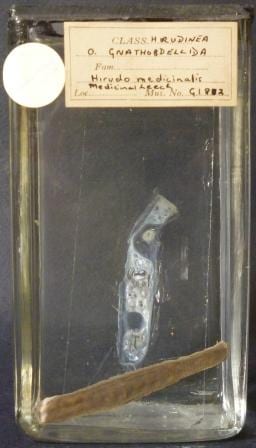Specimen of the Week: Week 125
By Emma-Louise Nicholls, on 3 March 2014
 This week’s animal is one that isn’t in need of ‘a little love’. Not because it gets a lot, because believe me- it does not, but because it just doesn’t care. I’m pretty confident it goes about its business, doing it’s thing, without a care in the world. I respect that. Though I’m not sure I appreciate this animal, not as much as perhaps I should? This week’s Specimen of the Week…
This week’s animal is one that isn’t in need of ‘a little love’. Not because it gets a lot, because believe me- it does not, but because it just doesn’t care. I’m pretty confident it goes about its business, doing it’s thing, without a care in the world. I respect that. Though I’m not sure I appreciate this animal, not as much as perhaps I should? This week’s Specimen of the Week…
**The medicinal leech**

The medicinal leech (Hirudo medicinalis), LDUCZ-G182.
FYI the exciting white part is in fact the glue,
the weird looking stick thing at the bottom is the leech specimen.
1) The body of the medicinal leech is a slightly flattened cylinder, divided into either 33 or 34 segments. The dorsal surface is dark brown-black in colour and marked with six long orange-red stripes running from the head to the ‘tail’. That makes them sound prettier than they are. The underside is covered in tiny spots. Less attractive sounding. At the head end, the leech has a disc-shaped sucker, in the centre of which is the mouth which contains tiny ‘teeth’. You’re probably well aware of its sucking reputation, but did you know that the medicinal leech also has ten eyes? Cool.
2) The medicinal leech is known from at least 24 countries across Europe, stretching as far east as the Ural mountain range in Russia. Although also present in both France and Belgium, it is not common. It may or may not please you to know, probably depending on where you are geographically located, that there are around 20 scattered populations of medicinal leech within the UK, ranging from Kent up to Argyll and Islay in Scotland, and from Norfolk across to Anglesey.
3) The medicinal leech inhabits areas of freshwater and tends to be found most commonly in small pools with a muddy substrate, that are surrounded by reeds. It prefers water that is eutrophic, and feeds on amphibious creatures that share its pool. This species of leech has been found feeding upon livestock in areas of the leech’s geographic range in which no amphibians are present.
4) The medicinal leech attaches itself to a host animal by piercing the skin with its teeth. It then injects an anaesthetic to numb the area, though not out of care in the community. The animal being fed upon does not feel the bite and remains unaware of the leech’s presence due to the anaesthetic, meaning the leech is able to feed in peace without the danger of being forcefully evicted. The leech also administers an anticoagulant chemical which prevents the host’s blood from clotting. This means that the blood continues to flow, making it easier for the leech to continue feeding.
5) The leech’s body visibly increases in size when it feeds and subsequently fills with blood. A medicinal leech can increase in size by 11 times its normal size after a feed. A meal of this size would mean that the leech wouldn’t have to feed again for over six months, which is great for the leech, but unfortunately can prove fatal for the host animal, if say, it’s a small species. This ability is important for an animal that does not have regular access to host animals from which to draw blood. If a leech is unable to find a host, it is able to digest its own body tissue in order to avoid starvation. Mmm, yum.
Emma-Louise Nicholls is the Curatorial Assistant at the Grant Museum of Zoology
 Close
Close



